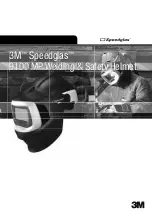
Automation Components, Inc.
2305 Pleasant View Road | Middleton, WI 53562
Phone:
1-888-967-5224 |
Website:
workaci.com
Page 4
BACnet MS/TP and Modbus RTU INTERFACE
The BACnet Master-Slave/Token-Passing (MS/TP) and Modbus Remote Terminal Unit (RTU) data link
protocol uses EIA-485 as a two-wire, daisy chain network. A branch is a discrete chain of devices connected
to a controller. The max number of devices per segment is 32, as per the BACnet and Modbus
specifications. 4000 ft (1219.2 m) is the maximum recommended length for a segment, which includes all
devices from the controller to the last device in the daisy chain.
BAUD RATE SELECTION
By default, BACnet Protocol and Auto-Baud is
factory set. If the sensor is field adjusted for
Modbus RTU, the baud rate should be selected at
this time to match the Master configuration. If
Modbus RTU protocol is selected it is
recommended the sensor unique address is
selected at this time. Switches 8-10 are used to set
the BACnet and Modbus baud rate. Refer to
TABLE
3
for switch settings. Where (0) is OFF and (1) is ON.
If the system’s baud rate is known, it is
recommended to set the specific baud rate to
match the system.
If the device is powered when a
change is made, the device must be power cycled
or reset for changes in baud rate to be made.
BAUD RATE
Auto-Baud
9600
19200
38400
57600
76800
Reserved
SW 8
0
0
0
0
1
1
1
SW 9
0
0
1
1
0
0
1
SW 10
0
1
0
1
0
1
0
TABLE 3:
BAUD RATE SELECTION
FIGURE 8:
SW4 DIPSWITCH
SETTINGS
**Note: Auto-Baud not available for Modbus RTU.
DIP 1 – PAR2 (only applies to Modbus)
DIP 2 – PAR1(only applies to Modbus)
DIP 3 – OPEN (For Future Use)
DIP 4 -- OFF is BACNET, ON is MODBUS
EOL TERMINATION RESISTANCE
SELECTION
RS-485 requires that the last device in a chain have
a termination resistor. This is controlled using a
jumper in the EN (enabled) position marked on
FIGURE 9
. When the jumper is set to EN (enabled), a
120Ω resistance is added in parallel to the data line.
When the jumper is set to DIS (disable), the
resistance is not added. By default, the jumper is
placed in the DIS (disabled) position.
SW4
OFF
ON
1
ON
2
3
4
BACnet MS/TP and Modbus
RTU INTERFACE
(Continued)
BACnet or Modbus RTU protocol selection is
done via SW4 switch. Place dipswitch #4 to the
OFF position for BACnet and the ON position
for Modbus. Refer to
FIGURE 8
.
ACI’s BACnet sensors are master devices. Only
master nodes are allowed to send and receive
tokens on the MSTP network.
ACI’s Modbus RTU sensors are slave devices.
Only one master is connected to the bus and
several slave nodes are connected to the same
trunk. The Master initiates communication. The
slave nodes only respond to a request from the
Master. Slave nodes do not communicate with
each other.
Each branch must have all devices connected
with (+) connected to (+) and (-) connected to
(-). If a shielded cable is used, this is not to be
connected to the devices. The shield cable
should only be connected on one end to earth
ground, usually at the controller. The start and
end of each branch should have a termination
resistor at the device level or at the controller.
Each device must be configured for the correct
baud rate and have a unique address in each
branch. The baud rate for the branch is set by
the controller. This product has auto-baud for
ease of network configuration but setting the
baud rate using the DIP switches is
recommended.
Note:
Auto-baud feature does
not function when Modbus is the selected
protocol.
FIGURE 9:
EOL TERMINATION
JUMPERS
END OF LINE
TERMINATION ENABLED
END OF LINE
TERMINATION DISABLED
EN
DIS
EN
DIS
Version: 2.0
I0000929


























